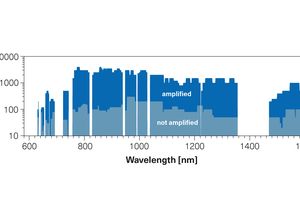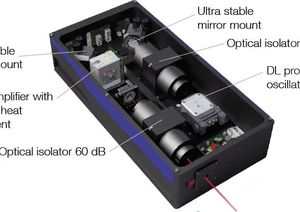 TOPTICA amplified diode lasers: Available wavelength and corresponding output power
TOPTICA amplified diode lasers: Available wavelength and corresponding output power


TA pro
Tapered Amplifier Laser System
- Wavelengths between 632 nm and 1590 nm
- High power up to 4 W
- Low noise and drift, narrow linewidth
- Stable and reliable with pro technology
- Convenient touch, knob and remote control with DLC pro
The TA pro is the flagship product of TOPTICAs high power tunable diode laser solutions. Its tapered amplifier technology allows for high power with excellent beam quality, while at the same time maintaining the favorable spectral properties of the pro master laser. The TA pro is a very well-established laser system optimized for extreme stability and ease of use, and has proved these properties in numerous tests in TOPTICAs and customers' laboratories.
The DLC TA pro is equipped with TOPTICA's all digital DLC pro control electronics: with lowest noise and drift and more convencience, it also offers highest amplifier currents up to 10 A and additional protection for the amplifier chip.
TA pro is also available as a TA pro AL with AutoAlign. TA pro AL allows integration of up to two complete MOPA systems. The AutoAlign feature can automatically optimize the coupling into the amplifier chip and fibers. For table-top TA pro AL systems, please inquire. The rack-mounted version of TA pro AL for integration in T-RACK is available as MTA pro.
With the TA pro F variant locking is faster than ever laying the foundation for the next generation quantum technology. The system features an intra-cavity EOM which provides two feedback channels. One is used for fast adjustments to ensure the superb locking performance, the other guarantees the high robustness of the lock.
-
Specification
Customized Top Seller (not configurable) DLC TA pro 670 765 780 795 850 DFB 780 DFB 852 F 674 F 729 Wavelength range [nm] 632 - 1590* 665 - 673 760 - 785 770 - 795 775 – 805 845 - 870 779 - 780 851 - 852 <672 - 674 <729 - >730 Max. output power [W] 4 1 2 4 3 3 4 3 0.35 0.5 Beam quality M² < 1.5 (< 2.0 for some higher power chips) < 1.5 < 2.5 < 2 < 2 < 2 < 2 < 2 < 1.5 < 1.5 Typical tuning range [nm] 10 .. 50 > 2 > 2 Mode-hop-free tuning [GHz] 20 .. 50 > 5 > 5 Typical instantaneous linewidth 90 kHz 100 kHz 0.5 kHz 0.6 kHz 0.6 kHz 5 kHz 2 MHz (5 µs)*** 2 MHz (5 µs)*** 30 kHz 1 kHz Polarization Linear > 100 : 1 ASE background typ. < -40 dB Divergence < 1 mrad Beam height 50 ± 1 mm Optical isolators Internal: 60 dB included, Output: optional 30 or 60 dB Internal and Output: 60 dB included Fiber coupling Output and probe beam: Optional Output fiber coupling efficiency** min. (typ.) 50 % (60 %) Monitor photo diodes For seed and output – also for output power stabilization Frequency modulation Mod AC and Mod DC inputs for seed laser included Slow and Fast inputs to EOM Intensity modulation TA-Mod for amplifier included Control electronics DLC pro (digital) Maximum TA current 5 A (with DLC pro TA), 10 A (with DLC pro TA HP) User Interface Multi-Touch, knob and total remote control Locking options DLC pro Lock, FALC pro, PDH/DLC pro, modules in DLC ext Dimensions laser head 90 x 192 x 400 mm³ (H x W x D) Weight laser head 9.5 kg Dimensions control unit 154 x 450 x 348 mm³ (H x W x D) Weight control unit 8.5 kg Power supply 100 .. 120 V / 220 .. 240 V AC, 50 .. 60 Hz (auto detect) Power consumption typ. 70 W Environment temperature 15 - 30° C (operating), 0 - 40° C (storage and transport) Environment humidity Non condensing *Spectral coverage with gaps
**With TOPTICA's FiberDock, isolation required
Specifications are subject to change without further notice
***Upper limit, see Application Note for more details - Additional Information
-
Options
Optical Isolation Single Stage

Isolators are used to protect the laser diode from back reflections. This not only prevents damage to the diode but also ensures untroubled single-mode operation and tuning. Fiber coupling with angle polished fibers (both ends) requires at least a single stage isolator. Optical Isolation Double Stage

Double stage isolators are needed if reflections from the experiment into the laser are expected. Fiber coupling with non-angle polished fibers also requires a double stage isolator. Fiber Delivery

Fiber Delivery (FD) is optionally available with TOPTICA's patented fiber coupler FiberDock and a suitable polarization maintaining (PM) fiber. FiberDock provides highest single-mode fiber coupling efficiencies, easy alignment and at the same time highest stability.
For most lasers, we specify a PER behind fiber of >20 dB with our Fiber Delivery option. Please also inquire about Long Life and High Power fibers as well as fiber splitters. Optical isolation is mandatory for fiber coupled diode laser systems.Locking and other electronics modules For DLC pro, the versatile DLC pro LOCK option is available as well as FALC pro and PDH/DLC pro modules. With DLC ext a number of analog locking modules is available. DFB master Optionally, a DFB master laser can be implemented for wide mode-hop-free tuning. -
Applications
- Atom and Ion cooling and trapping
- Bose-Einstein Condensation & degenerate Fermi gases
- Rydberg Excitation (Rydberg Flyer for complete laser solutions)
- Optical Clocks
- Quantum Optics
- Spectroscopy
- Metrology
-
Downloads
- Product info: TA pro
- Technical Drawings: TA pro
- Video : TA pro - amplified
-
Literature
Application Note
- Trapping and quantum computing
- Phase and Frequency Locking of Diode Lasers
- Linewidth Measurement of Diode Lasers
Current scientific Publications mentioning TOPTICA TA pro
-
Related Products
- MTA pro Modular Amplified Tunable Single-Mode Laser System (rack mounted TA pro)
- BoosTA pro: Semiconductor optical power amplifiers
- Tapered amplifier chips for an overview of available wavelengths and powers
- DLC pro: fully digital driver electronics. Low noise with intuitive multi-touch UI
- CTL: Continuously tunable diode laser
- DL pro: the ultimate Littrow ECDL - stable and user friendly
- DFB pro: Diode laser with few-nanometer mode-hop free tuning and broader linewidth
- Frequency converted diode lasers for all other wavelengths
- AR, FP, and DFB Laser Diodes
- Numerous Photonicals, tools and helpful equipment for working with lasers, for example Fabry-Perot Interferometers

